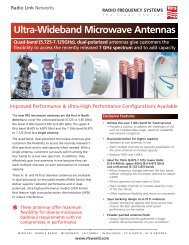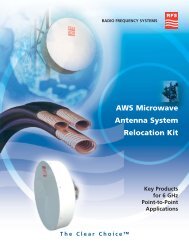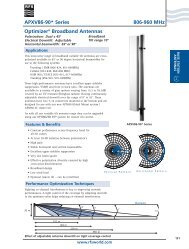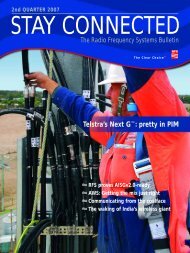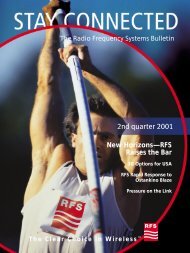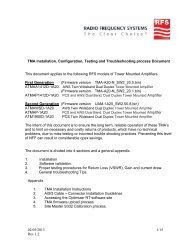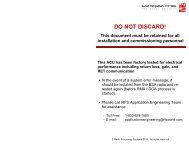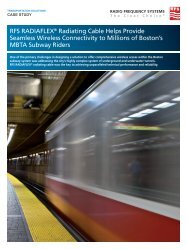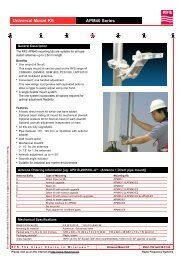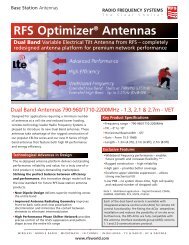download - Radio Frequency Systems
download - Radio Frequency Systems
download - Radio Frequency Systems
You also want an ePaper? Increase the reach of your titles
YUMPU automatically turns print PDFs into web optimized ePapers that Google loves.
Bill Engst and the CAT application—<br />
a program that speeds the manual<br />
tuning process.<br />
a more versatile automated tuning option<br />
dealing with smaller batches for specific<br />
applications. Until early-2004, the speed of<br />
the robot determined the necessary<br />
processing speed of the software. At a safe<br />
speed, the robot could take up to a minute<br />
to execute a tuning stage, moving from one<br />
tuning screw to another, back and forth.<br />
Because of this, the tuning software itself<br />
was not time-critical.<br />
CAT for short runs<br />
Engst’s proposal was to further develop the<br />
tuning software so that it could serve as an<br />
12<br />
RF<br />
CONDITIONING<br />
analytical tool for human manual tuning, in<br />
the case of smaller batch runs. “I saw a guy<br />
tuning by hand for a ‘one-off’ customer<br />
and it was taking him so long. That’s when<br />
the light bulb clicked and I realized we<br />
needed to update the software to<br />
real-time,” says Engst.<br />
Based on this realization, RFS developed<br />
computer-aided tuning (CAT) software—a<br />
program that allows a human tuner to<br />
expedite the tuning process. “What<br />
CAT does is collect data, measure a<br />
difference between the data and a<br />
goal, then display this as a bar-graph<br />
on a screen—it updates every half<br />
second or so,” says Engst.<br />
The benefit of the CAT software is that it<br />
allows RFS to tune its smaller volume and<br />
sometimes more-complex filters much<br />
faster, at a lesser investment than the robot,<br />
yet retain the consistent reliability. By<br />
streamlining the tuning stage, each filter<br />
production line has realized increased<br />
throughput as well as a faster and more<br />
flexible response to customers’ orders.<br />
“Initially we’d tested CAT in the lab by<br />
tuning a 10-pole delay filter—which is quite<br />
complicated to tune—and it was able to do<br />
it easily,” says Engst. This proved the CAT<br />
software’s ability to speed the introduction<br />
process of new and complex filters into<br />
commercial production cycles. Also,<br />
because the CAT software actually analyzes<br />
the filter in order to tune it, it knows<br />
instantly if there is a problem with the<br />
unit, which means no time wasted<br />
troubleshooting.<br />
The CAT software was first introduced into<br />
the Connecticut production line in March<br />
2005, and in conjunction with the robotic<br />
tuners, allows RFS to provide its customers<br />
with fast-tracked deliveries of all filters.<br />
“The power of these tools is that they<br />
can look into the filters and know<br />
exactly what’s going on inside,” says<br />
Engst, “Which means there’s no<br />
guesswork—we’re giving our customers<br />
exactly what they’ve asked for, every time<br />
and on time.”<br />
The robotic tuning head takes less than<br />
five minutes for one filter.<br />
The robots running in RFS’s Connecticut<br />
and Hillerød facilities tune up to 150<br />
filters every day.



